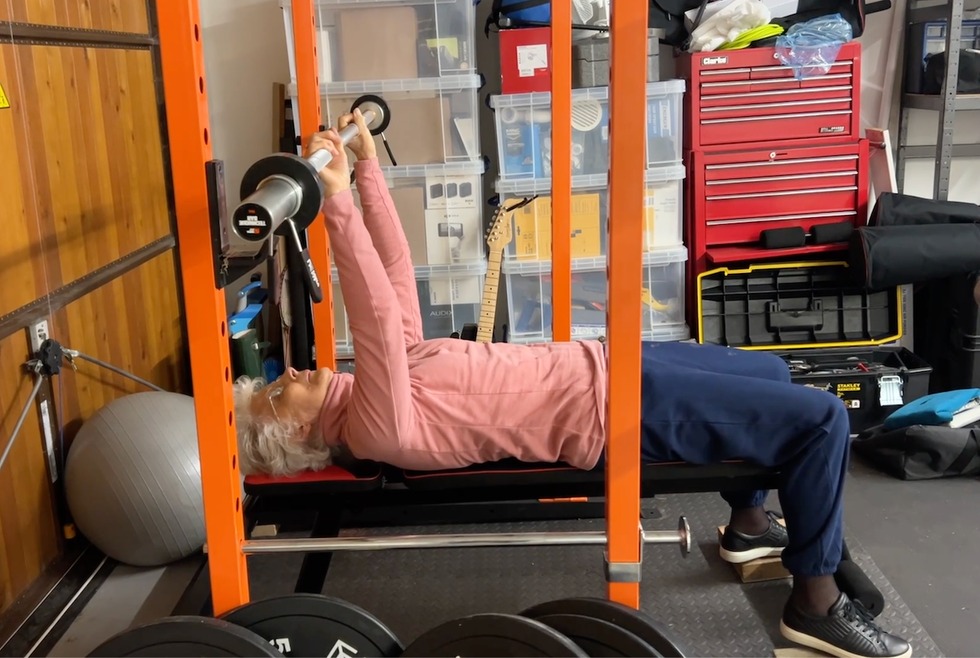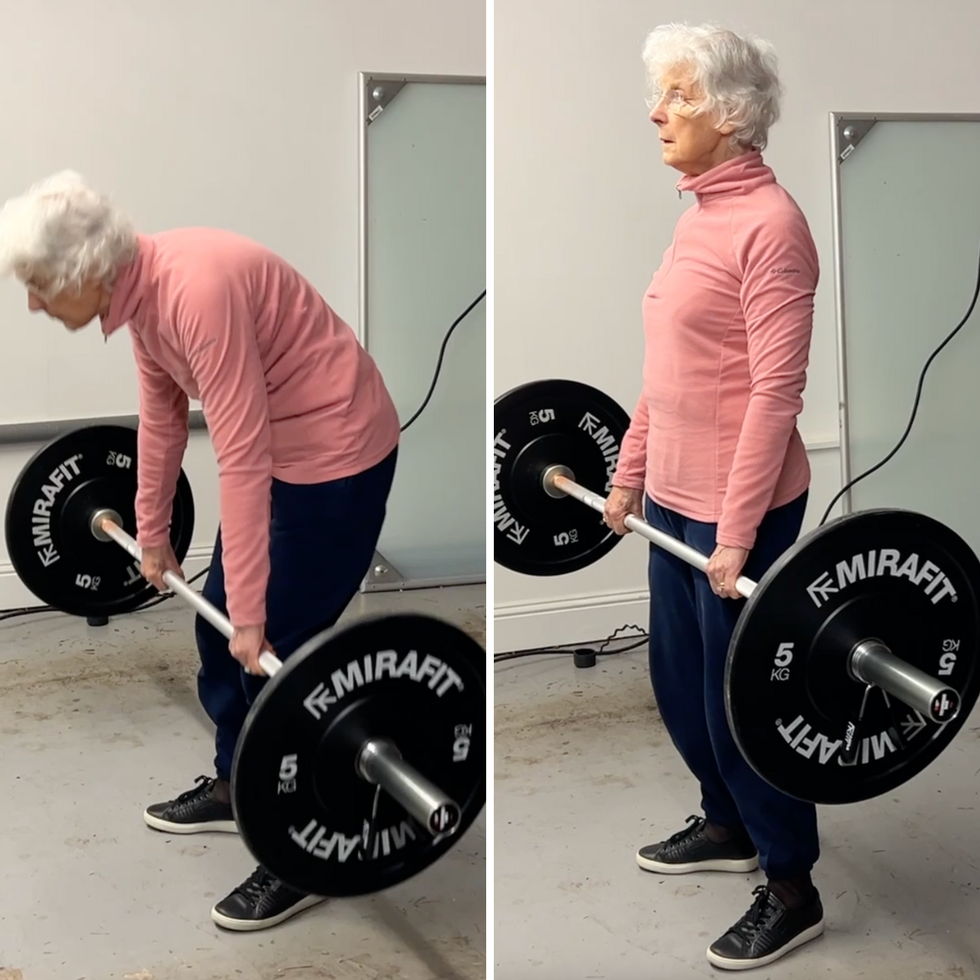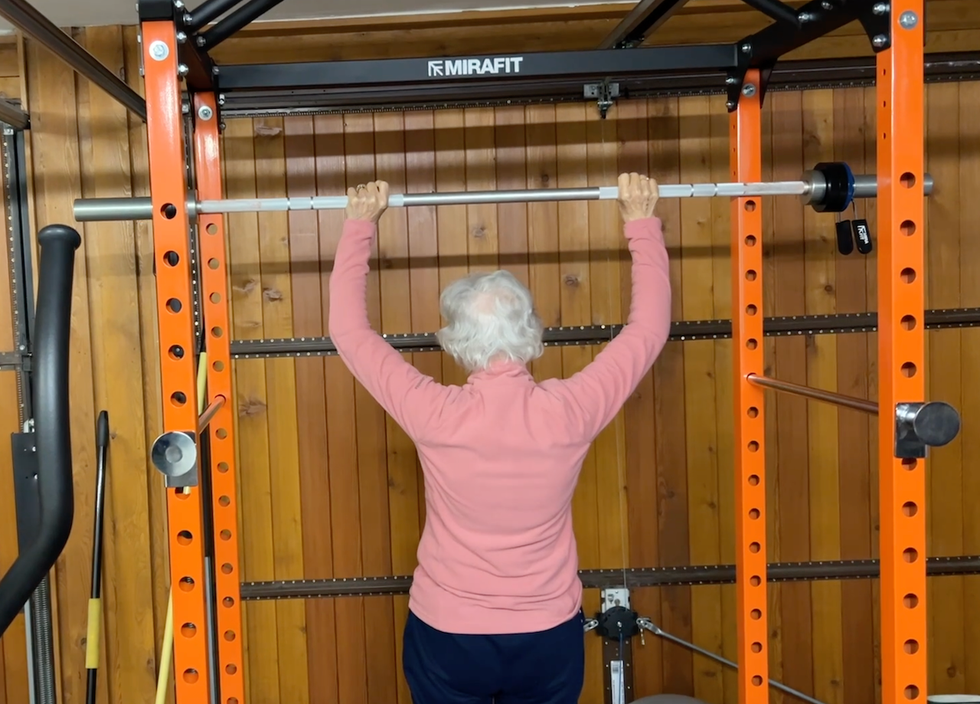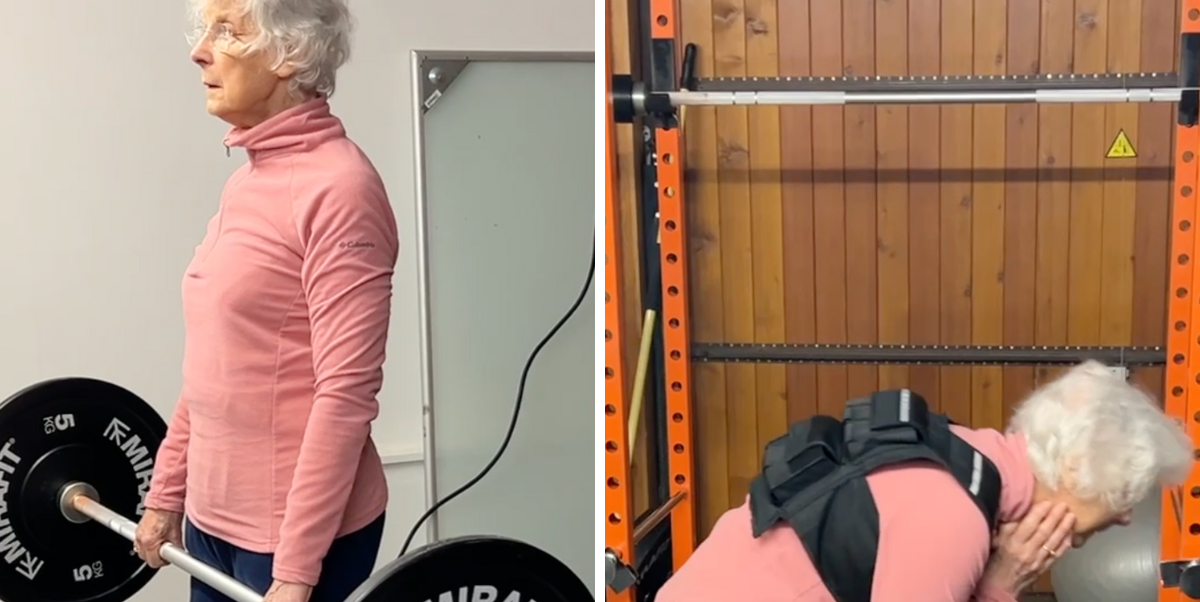When journalist Clare Johnston interviewed renowned physical therapist and strength coach Chris Reis for her YouTube channel (‘The Honest Channel’), which explores healthy ageing, she decided to start weight training ASAP. Hearing about the dramatic results Reis had seen in older people who’d started lifting weights, Johnston was keen for her 82-year-old mum Rhoda to try weight training, too. The results surprised everybody.
In just six months, Rhoda, who had suffered severe muscle loss in her back due to osteoporosis in her spine – and could not walk for more than 30 seconds unaided – can now hold her back up straight and walk at speed for three minutes.
‘My mum is proving that it’s possible to reverse frailty in later life through weight training,’ Johnston says of the ‘jaw-dropping’ difference in Rhoda’s posture and ability to walk briskly in this update video.
Brisk walking can have numerous health benefits, including building stamina, burning excess calories, and making your heart healthier, according to the NHS.
You don’t have to walk for hours to reap the health rewards, either. The NHS says that a brisk 10-minute daily walk has many health benefits, and counts towards your 150 minutes of weekly exercise, as recommended in the physical activity guidelines for adults aged 19 to 64. Well, at 82, Rhoda hopes to get there and possibly beyond, with Johnston writing in a recent post that she’s now determined to be able to walk upright again unaided for much longer periods of time.
By building muscle later in life, then, Rhoda has also improved her mobility, essentially reaping double rewards. So, how did she do it, and what routine does she follow now?
The importance of compound movements
Aware of Reis’s work with 98-year-old Merce Hershey, who improved her bone density through weight training, Johnston’s parents were keen to try a similar programme, in which compound movements are key.
As Johnston explains in a two-month follow-up of Rhoda’s strength training programme, a compound movement ‘basically means working multiple muscle groups with one exercise, which is one of the best ways to build all-over strength – and in our experience, that happens pretty quickly.’
The barbell, she adds, has also been key and helped Johnston herself see more progress than a year of working out at the gym three times a week. ‘Although I was going through the motions and doing leg presses and curls and seated overhead presses and pull downs, I didn’t make half the progress that I have using compound movements with a barbell, where I’m covering several muscle groups at once and just gradually increasing the weight week to week,’ she says in the video.
Rhoda’s workout routine
Rhoda has been training under Reis’s guidance via online video training sessions.
MondaysWeighted vest squats
As outlined in Clare’s recent write-up of her parents’ strength training routine, Rhoda uses a weighted vest rather than the bar for this exercise. She began with 1kg added to the vest, squatting down to a bench. When she progressed to around 18kg on the vest, Rhoda slightly lowered the bench height and vest weight, squatting a bit deeper, but with 15kg of weight. She’s now working towards full-depth squats using the bar.
Asked in the follow-up video whether she had surprised herself after eight weeks of training, Rhoda says: ‘I surprise myself most times we train. The thing is, we train together, and when I see what he [her husband Michael] is doing, I think to myself, how am I going to do that when it comes to my turn? But so far, I’ve done what I’ve been asked to do.’
 Clare Johnston / Oliver Johnston
Clare Johnston / Oliver Johnston
Rhoda is now working towards full-depth squats using the bar
Bench press
As part of her Monday workout, Rhoda also does the bench press. She warms up with lighter weights before pressing her top weight (which is currently around 18kg), and progresses by about 1kg each week.

Clare Johnston / Oliver Johnston
Deadlifts
Rhoda finishes the Monday session with deadlifts. After warming up with lower weights, she will deadlift whatever her top weight is, which is currently an impressive 32kg.
 Clare Johnston / Oliver Johnston
Clare Johnston / Oliver Johnston
Compound movements like deadlifts have helped Rhoda, 82, improve her posture and mobility
Thursdays
On Thursdays, Rhoda follows a similar routine, but swaps out the bench press for a rack press. According to Clare’s recent update, Rhoda warms up with lighter weights, before lifting her top weight – currently doing 7 sets of 2 reps, with adequate recovery time between sets, which is crucial.
 Clare Johnston / Oliver Johnston
Clare Johnston / Oliver Johnston
On Thursdays, Rhoda and her husband Michael swap out the bench press for the rack press
What differences has she seen?
Even after just eight weeks of training, Rhoda reported seeing several improvements in her everyday life. ‘The first thing I noticed was, when I was doing my cleaning, for instance – cleaning the house – I noticed that I could go further and longer without being tired,’ she says. ‘I’m noticing that I can get up and down the stairs much more easily without being out of breath and my heart pounding, and my limbs, my back, my legs are much stronger and can carry me further.’
Later on, Rhoda also became able to stand upright again to wash her hair in the shower, and she can now sit up independently from a lying position on the bench. While she continues to notice small improvements every day, Rhoda says her aim is still to be able to hold her upper back straight for longer periods.
‘When I first shared videos of them lifting weights right at the start, I had a couple of people say they thought my mum looked frail and they were asking should she really be doing this,’ says Johnston. ‘And I would say this is proof that you can overcome frailty and see big improvements in just a short period of time, at any age.’
Indeed, provided you take the correct safety measures and train with expert guidance, it’s generally never too late to benefit from weight training. Age-related muscle mass loss – otherwise known as sarcopenia – is common and can lead to impaired mobility, falls and general frailty. Women can be at a higher risk of sarcopenia from a younger age due to factors including menopause-related hormonal changes and the fact that we tend to have less muscle and more fat than men in early and middle age.
So, while 82-year-old Rhoda may have shown that it’s never too late to start strength training, there’s also no better time than the present – the earlier you start lifting weights, the earlier (and longer) you’ll benefit.
Related Stories
Hannah Bradfield is a Senior Nutrition Writer across Women’s Health UK and Men’s Health UK. An NCTJ-accredited journalist, Hannah graduated from Loughborough University with a BA in English and Sport Science and an MA in Media and Cultural Analysis.
She has been covering sports, health and fitness for the last five years and has created content for outlets including BBC Sport, BBC Sounds, Runner’s World and Stylist. She especially enjoys interviewing those working within the community to improve access to sport, exercise and wellness. Hannah is a 2024 John Schofield Trust Fellow and was also named a 2022 Rising Star in Journalism by The Printing Charity.
A keen runner, Hannah was firmly a sprinter growing up (also dabbling in long jump) but has since transitioned to longer-distance running. While 10K is her favoured race distance, she loves running or volunteering at parkrun every Saturday, followed, of course, by pastries. She’s always looking for fun new runs and races to do and brunch spots to try.
